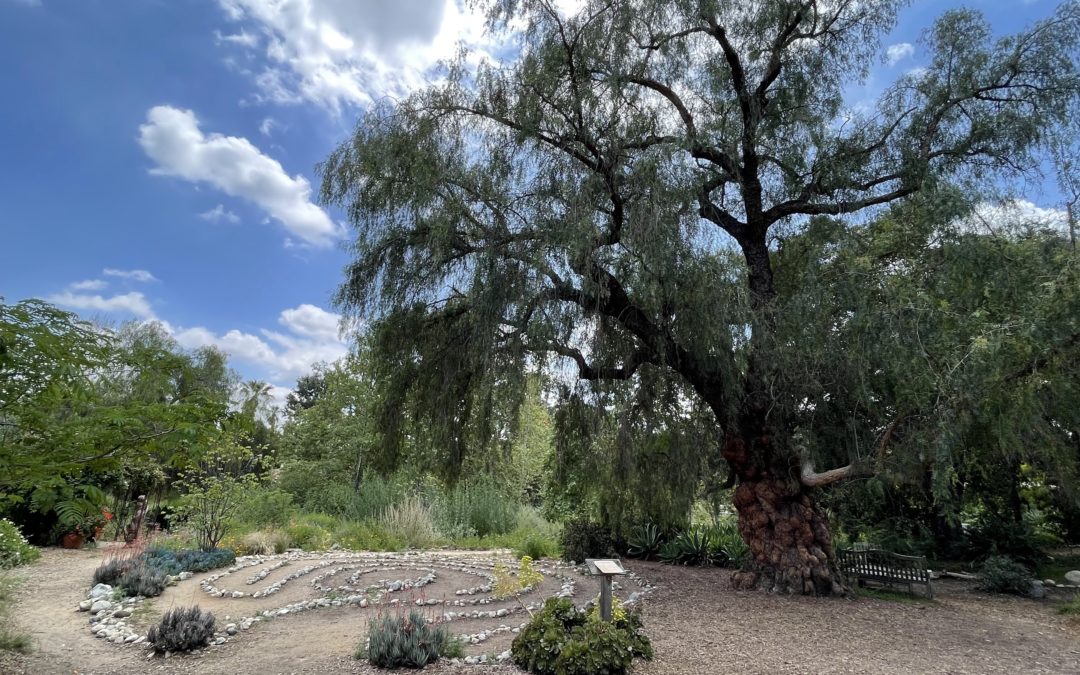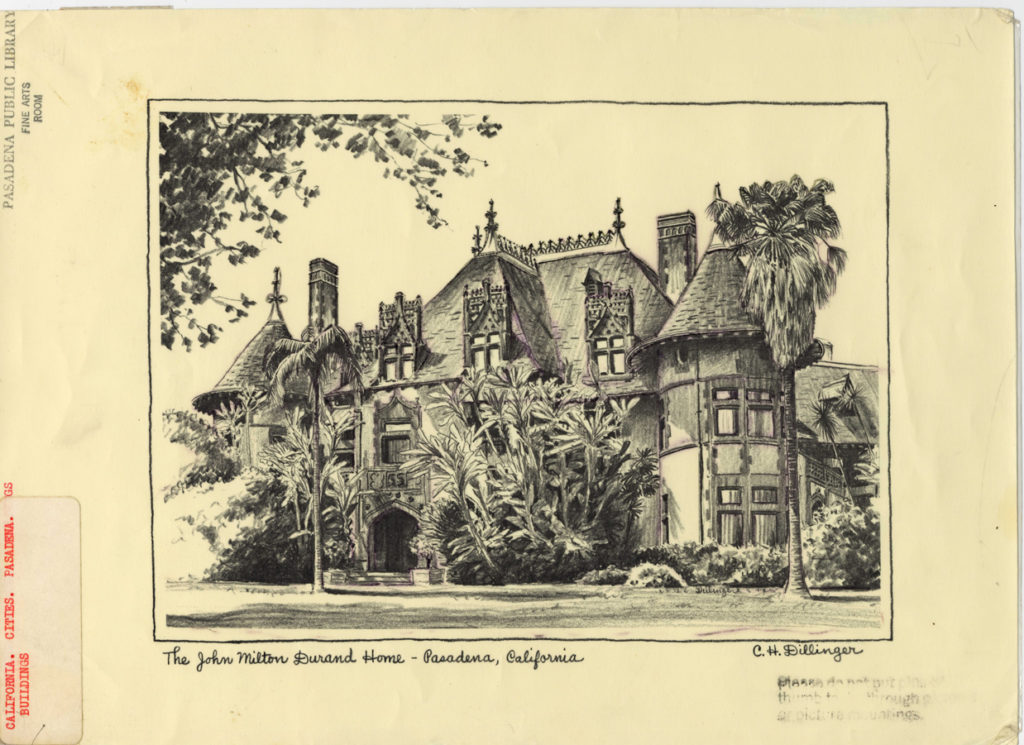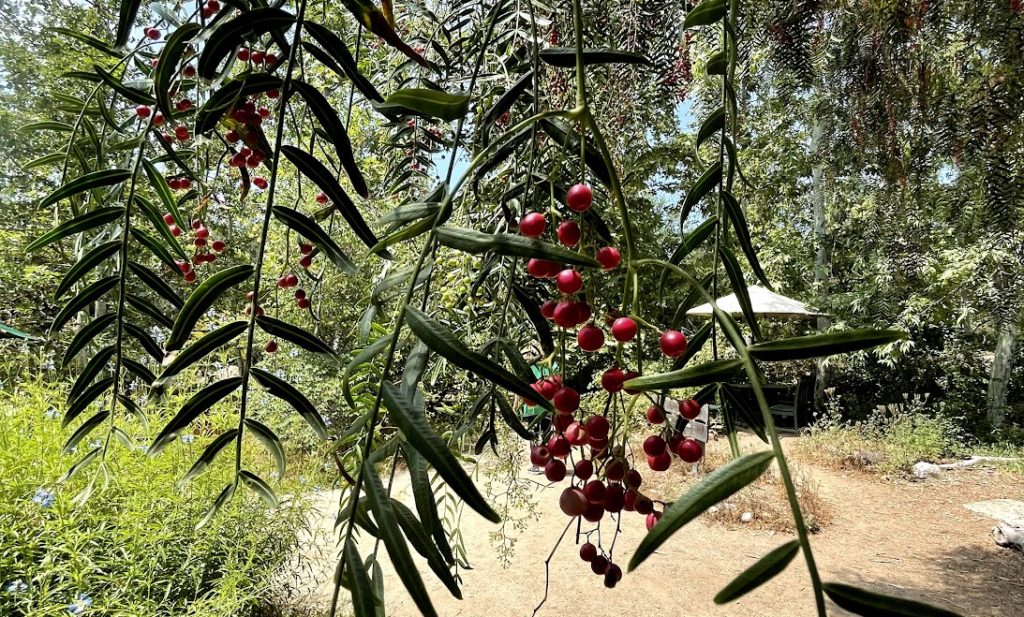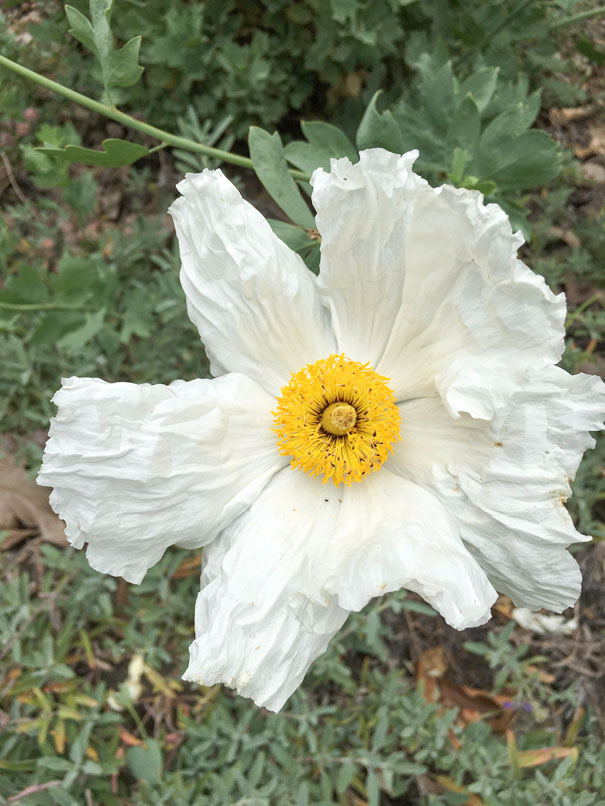Arlington, Overworld is a monthly series devoted to the plants of Arlington Garden. The “overworld” is the highest-level map of a videogame showing mountains, forests, kingdoms, dungeons, and treacherous wastes. Not part of normal gameplay, the overworld facilitates progression from level to level — AJ Jewell.
California pepper tree: Schinus molle, Peruvian pepper tree, molle del Peru (Spanish), mulli (Quechua)
Origin: Peruvian Andes, central Chile, and parts of Argentina
Mature height and width: 35-45 ft. tall and 50-75 ft. wide
Gardening notes: an evergreen tree often wider than tall with drooping branches; female trees have panicles of pink fruits (peppercorns); extremely adaptable, Arlington does not recommend planting this species, because it is classified as invasive by the California Invasive Plant Council; due to the threat this species presents, all female trees have been removed from Catalina Island to prevent competition with native oaks.
THE MASSIVE “CALIFORNIA” pepper tree pictured above was one of only eight trees on site when Arlington broke ground in 2005. The common name “California” is a misnomer, since the species is endemic to Peru and Chile.
Schinus molle trees produce pink fruit “peppercorns” that are eaten by humans and birds—but be cautious! The tree is a member of the cashew family and presents a documented potential danger to people with nut allergies. In fact, there was a widely publicized dust-up between the FDA and France about the health effects of pink peppercorns in the 1980s.
Authorities continue to disagree about the risks associated with eating the fruits even for non-allergic people: an official Queensland Australia government website lists them as potentially toxic to humans and others continue to caution about dangers specifically to children, pigs, and poultry. That said, they continue to be widely sold and eaten in the United States, and they have been fermented and consumed in Peru for over a thousand years.
DURAND HOUSE
This tree was once part of the gardens of the strange and fabulous Durand House, a 50-room mansion home to John Durand, a wealthy wholesaler from Chicago. The mansion was designed in the style of a baronial French chateau and included intricate wood carvings, a red sandstone exterior, and gardens with high-maintenance plantings: roses, orange trees, and palms.
It was so extravagant that the Los Angeles Times heralded it as “the most peculiar and at the same time the most lavishly finished residence not only in Southern California but in the whole country.” It was peculiar both for its sheer extravagance – the interior “locks, hinges, doorknobs, drawer handles, etc.” were made of expensive gold alloy – but also for such strange amenities as a light switch next to Mrs. Durand’s bed that turned on “every light in the house from cellar to roof,” more than 600 lights, apparently as a form of burglar deterrence.
The Durand property and its furnishings were sold at auction in the 1960s and then razed to the ground. The only traces left of the mansion are a small walkway, and a fragment of the original facade built into Arlington’s Pomegranate Amphitheater.
Caltrans later set aside the property as a staging ground for the 710 freeway expansion, but local opposition to the freeway halted construction. The lot remained empty for 40 years until the creation of the garden in 2005 by a group of dedicated Pasadena residents. In the decades since, the original trees — such as this California pepper tree – have ended up in the middle of a swiftly growing forest. What do they think of the new arrivals?
AN ANCIENT ALCOHOL
The Wari (Huari) empire in the Andes flourished between 650 to 1000 CE and was an agricultural civilization predating the Inca. Archeological evidence shows that “elites” among the Wari drank copious amounts of alcohol made from Schinus molle berries. This alcohol was probably similar to a beverage that Spanish later called chicha, which continues to be made from ingredients including corn and quinoa and – now very infrequently – Schinus molle. The Spanish Jesuit Bernabé Cobo described chicha de molle thus:
It produces a little red fruit in racemes like the willow of which the Indians make chicha, and it is so strong that it makes one drunk more than that which is made of maize and other seeds, and the Indians consider it more valuable and a delicacy. (Bernabé Cobo, Historia del nuevo mundo, 1653; trans. Sophie Coe; quoted in Sayre et. al. “A marked preference.”)
According to some sources, traditional knowledge of this drink is disappearing. A 2004 study of the beverage in Peru found only one person who still knew how to make it, and he had not made any since he was a child. Other sources claim the beverage continues to be widely consumed in certain regions of Peru. The process is labor-intensive: 20 liters of chicha require over 4,000 ripe berries, each of which must have its tiny papery sheath and stem removed before boiling!
The Spanish, for their part, were responsible for transporting Schinus molle throughout their sphere of influence including California. They were interested in the tree primarily as a spice, rather than an alcohol, and apparently hoped to use it to challenge the East India Company’s black pepper trade.
Select Additional Sources:
Myers, Kirk. “The Home with Golden Doornobs.” Pasadena Museum of History, Pasadena (2011).
Thank you to John Ripley for his research on the Durand Mansion for Pasadena Heritage.






Recent Comments